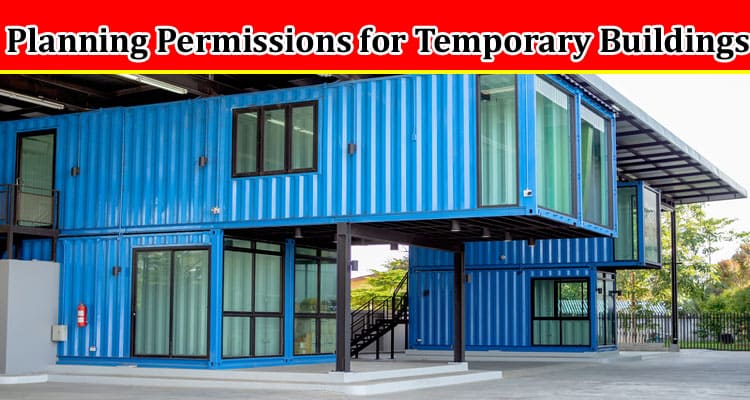Temporary structures are a cheaper and more cost-effective solution than conventional buildings. Businesses looking for cheaper storage spaces can go for temporary or semi-permanent structures because they are versatile and portable.
Planning permissions and building regulations are part of construction projects. However, the rules may be different depending on some factors. You may need permits and building regulations when setting up temporary structures.
In this guide, we will discuss planning permissions for temporary structures.
What Are Temporary Structures?
Temporary structures, also known as semi-permanent buildings, are designed for short-term use. However, these structures can be customized for both storage and accommodation purposes. The structures are built using prefabricated materials to cut construction costs.
There are different types of temporary structures in the market. Some of the most common examples available at Smart-Space are industrial tents, steel-framed structures, and clear-span buildings.
Industrial tents are the cheapest and come in handy during emergencies. They are cheap to install, portable, and versatile. You also have the option of leasing the structure if you are only using it for a few weeks or months.
What is a Planning Permission?
Planning permission is issued by the local authority in your city or town. We can describe it as the go-ahead or green light from the authorities so that construction can commence. However, the permit can be denied if there are issues during the feasibility studies.
The approval process can take anywhere between 8-12 weeks. If a project doesn’t get the approval, the owner can make the necessary changes as recommended by the local authority and reapply.
There are some instances where you don’t need to apply for planning permission. One common example is extension projects. Most of these projects are covered under the permitted development clause. However, we will cover more instances where you may not require planning permission for your project.
Don’t confuse planning permission for building regulations. They are both required by law and one can’t be substituted for the other. Building regulations take care of the safety of the structure and those who will be using it.
A certificate to show that the structure meets the building regulations is offered after the project is completed. An inspector from the city or town council will visit the construction site regularly to check on the project and ensure that everything is up to standard.
The Process of Applying for Planning Permission
The process of getting planning for temporary buildings is similar to that of conventional structures. Step one involves a site survey and design meeting with a professional from the local authority in your city.
After the design meeting, you have to prepare your planning permission drawings. The drawings will include everything from your architect and supporting documents to the quantity surveyor and site engineer. Pay extra attention to ensure that all of the documents are in order with no errors.
If you’re still unsure about the process and pointers to relevant government websites, why not try this out? Other than links to government websites, you will also get recommendations and best practice guidelines from experts in temporary buildings.
Once you have everything ready, you can submit a digital copy of the documents through the planning portal. However, in some states, you may have to submit the documents to the relevant offices.
How Planning Permissions Are Approved
The approval process is intense and can take two to three months before you get a response from the authorities. The consultant will visit the proposed construction site to see what resources or utilities will be affected by the project. They will also talk to the community to get their views about the project.
Step two involves reviewing your documents to see if the measurements and drawings are correct. During this stage, the consultant may contact you if any changes need to be made to the design of the structure.
However, errors in the design and supporting documents can lead to a rejection from the local authority. You will need to make the corrections and reapply. The process can affect your project’s timeline, so take your time to ensure that all of your documents are correct.
Why Do You Need Planning for Temporary Structures?
Planning permits and building regulations are legal requirements when setting up certain types of structures. Not getting a planning permit can get you into trouble with the law. In such instances, you may get charged in a court of law.
Other than that, you will have to pause the project and get the necessary documents first. In extreme instances, your project may be demolished.
Planning for temporary structures ensures that the project meets the set standards, is safe to the environment, and shows its impact on the community and resources.
Where You Don’t Need Planning Permission
The rules or conditions may change depending on which state or city you live in. We recommend consulting a professional first to avoid getting into legal trouble. As mentioned, extension or conversion projects can be covered under the permitted development clause.
Though you may not need a planning permit, you still have to inform your neighbors before you begin the process. You also don’t need planning permission for a structure that has a floor space of under 100 meters square and will not be used for more than four weeks.
Another case is if the temporary building is shorter than the original structure and the floor area is no more than 25% of the property.
Planning for temporary buildings runs for three years, and after that, you need to move the structure or reapply for planning permission.
Wrapping Up
Temporary structures are a good and cost-effective option, especially for businesses looking for extra storage or office space. There are many options available on the market including customized designs, even though they can be costlier.
Planning permission is a significant part of the construction of both conventional and temporary structures. Factors such as the size of the project will influence how long it will take to get approval after submitting the documents.
We recommend hiring a construction consultant to help you during the application process as the consultant will ensure that all of your documents are ready and in the correct order before submission. They will also advise you on best practices depending on the type of temporary structure you are setting up.





